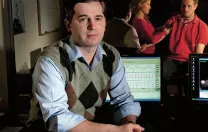If many questions about suicide remain unanswered, even less is known about nonsuicidal self-injury. In the United States, an estimated 4 percent of adults and 21 percent of adolescents engage in such behavior; its incidence has not been well studied in other countries. Research has not yet revealed a treatment approach that works reliably. Self-injury is under consideration for inclusion as a phenomenon in the next edition of the Diagnostic and Statistical Manual of Mental Disorders (DSM), but, says professor of psychology Matthew Nock, “There’s no agreement right now on the threshold”--in terms of frequency or severity of self-injury--“that requires treatment.”
People who engage in self-injury report feeling relief afterward, but little is understood about the physiological effects of such behavior. It is assumed that there is some sort of endorphin rush related to the body’s survival response, similar to what people experience after non-self-inflicted injury, but that is only a hypothesis.
Work in Nock’s lab has shown that people who engage in self-injury have higher pain thresholds: when their hands are compressed in a vise, it takes them longer to experience pain, and they have higher pain tolerance. And this tolerance is not related to the length of time they have been engaging in self-injury, or the frequency--suggesting, says Nock, that the heightened pain threshold “is not a consequence of self-injury, but a precursor.”
Studying people at the moment of self-injury--for a detailed analysis of the biological markers it triggers--is difficult, but Nock is trying. He and Wendy Berry Mendes (formerly an associate professor at Harvard, now at the University of California, San Francisco) are measuring what happens in the bodies of adults who engage in self-injury by using an ambulatory monitoring device called the LifeShirt, a mesh vest (worn beneath clothing) that records vital signs so the researchers can compare physiological changes to the subjects’ reports of their own mental states and behavior.
Childhood adversity is known to be a risk factor for self-injury; to investigate this link, Nock designed a study that examined parents’ style of talking about their children. “We brought parents into the lab and asked each to talk about his or her child for five minutes,” he explains. “That’s essentially the only instruction we gave them.” The parents of children who engaged in self-injury “were much more hostile and critical in the way they talked about their children,” he says, suggesting that children may internalize this hostility and criticism and inflict it on themselves physically.
As recently as three years ago, there was no standardized form for interviewing patients about self-injurious thoughts and behavior. Nock developed one; since its 2007 publication, it has been downloaded thousands of times and translated into languages including Swedish, German, and Japanese. Nock edited the 2009 volume Understanding Nonsuicidal Self-Injury; now, researchers in his lab are studying whether self-injury has a social and communicative, as well as a physiological, function: whether it replaces verbal communication as an outlet in people who have poor verbal skills or whose family and friends are not receptive to communicating about emotions.
Although self-injury accompanies other mental-health disorders--such as anxiety and depression--Nock believes it is not just a symptom of these other disorders, but worth studying, understanding, and treating in and of itself. For one thing, he says, “We know that engaging in self-injury significantly increases the likelihood that someone will make a suicide attempt.”









